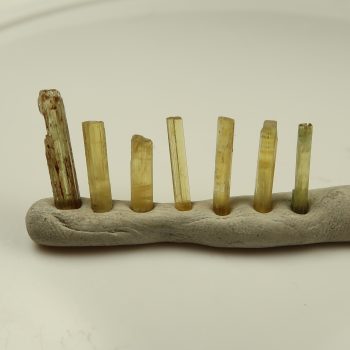Heliodor
Heliodor is the name given to a greenish yellow variant of the mineral Beryl, while golden yellow Beryl is referred to as ‘Golden Beryl’. However, the names are often used interchangeably for both variants.
Beryl has a hardness of 7.5-8 on the Mohs scale and occurs in several other gemstone variants – Emerald, Aquamarine, Morganite, and Goshenite.
High grade Heliodor is faceted and sold for jewellery making.
Showing the single result
Appearance, Uses and History
Heliodor is the name given to a greenish yellow variant of the mineral Beryl, while golden yellow Beryl is referred to as ‘Golden Beryl’. However, the names are often used interchangeably for both variants.
Beryl is primarily used for jewellery making or sold as mineral specimens – and Heliodor is no exception.
Beryl was used for eyeglasses in 13th century Italy as the processes for glassmaking could not produce lenses with enough clarity.
The worlds largest known crystal is Beryl, an 18 metre tall crystal from Madagascar weighing around 380 tons.
Locales
Heliodor crystals are found in Afghanistan, Brazil, Czechia, France, Madagascar, Norway, Pakistan, Portugal, Russia, Ukraine, the USA, Vietnam, and Zimbabwe.
I’ve held stock from Afghanistan, Brazil, Pakistan, Russia, and Vietnam, some of which was very nice – the Afghani material and the Vietnamese material tend to have an excellent colour while keeping towards the budget end of the pricing spectrum.
Mineralogy
Hazards and Warnings
Almost all rocks, minerals (and, frankly, almost all other substances on earth) can produce toxic dust when cutting, which can cause serious respiratory conditions including silicosis.
However, Beryl is a beryllium compound which can cause Berylliosis.
Given that this disease can be caused by as little as a single exposure to Beryllium, any lapidary intending to work Beryl should do careful research and make sure their extraction and respirators are correctly rated.
When cutting or polishing rocks, minerals, shells, etc, all work should be done wet to minimise the dust, and a suitable respirator or extraction system should be used.
Translations
Arabic:
- هيليودور
Hindi:
- हेलिओडोर
Portuguese:
Bengali:
- হেলিওডর
Indonesian:
Punjabi:
English:
- heliodor
- beryl
Italian:
Russian:
- гелиодор
French:
- héliodore
Japanese:
- ヘリオドール
Spanish:
German:
Korean:
- 헬리오도르
Thai:
- เฮลิโอดอร์
Gujurati:
Mandarin and Traditional Chinese:
- 金色绿宝石
- 黄透绿柱石
- 黄绿宝石
Urdu:
- ہیلیوڈور
Further Reading / External Links
- https://www.mindat.org/min-6727.html
- https://www.gemsociety.org/article/heliodor-golden-beryl-jewelry-gemstone-information/
- https://geology.com/gemstones/heliodor/

